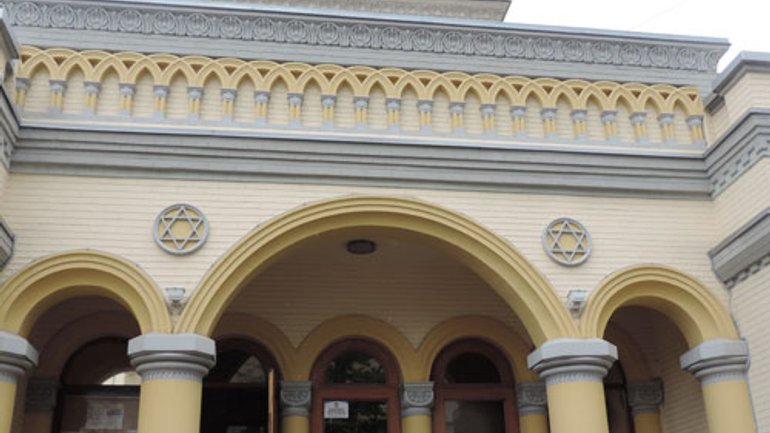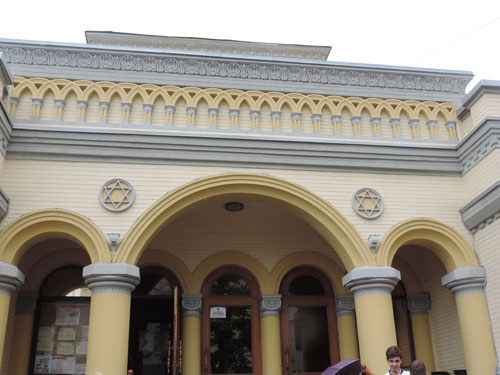Brodsky Synagogue at the heart of the Ukrainian capital

Located in the city center, the ancient synagogue named Lazar Brodsky and the former theater attracts a lot of views, but no one dares to enter it. However, the members of the Jewish community are ready to answer all the guests’ questions. Thus, recently a delegation of the Youth Association of Religious Studies has visited it to learn more about the monument of art.
Brodsky Synagogue in Kyiv
Already at the entrance to the building it becomes clear that the special situation in the country prompts new solutions – the advertising of courses of self-defense and martial arts hangs all over the walls, and at the entrance to the synagogue everyone passes two frames, showing the contents of their bags to scrupulous guards. Immediately after the examination in the dim lobby we were met by David, First Assistant to Chief Rabbi of Kyiv Moshe Reuven Azman (Congress of Jewish Religious Organizations). He retells the story of the premises in easy and simple manner, diluting the story with his best jokes.
The decision to build this synagogue was taken in a somewhat original way, because neither the authorities nor the majority of Kyivans were fully aware of what was actually constructed in the center by the first guild merchant Brodsky Lazar Izrailevich. It should be mentioned that first in Kyiv there was an effective ban on the construction of a synagogue in the city center, but at the same time the city government issued an order for market construction market in which merchants were involved, as a result the modern Bessarabian market was constructed. In addition, due to lack of funds it was almost the only case of effective use of municipal bonds.
Brodsky Choral Synagogue was opened in Kiev on August 24 (September 5) in 1898 (dedicated to the 50th anniversary of the Builder). It was built by the architect George Shleifer with the help of Lev Ginsburg 's constriction firm at the expense of Lazar Brodsky. The synagogue’s closure took place in 1926 when it was transferred to the Artisan’s club, later it also served as a theater. In 1970 the second floor of the building was completed. The room acquired its original status of a synagogue anew on March 14, 2000, after celebration in 2008 of its 110th anniversary.
Having completed the larger historic part of the tour, David took us into a large prayer hall for men, making sure that the presence of women did not disturb anyone. Usually the women are prohibited from entering, they are to stay on balconies. The reason of this practice is very simple – according to Jewish views the desire is not inherent in ten nature of woman, so the presence and appearance of men does not distract her from the prayer, which cannot be said of the members of stronger sex. Then the beautiful half of humanity began to pray on balconies, leaving the lower central hall for men, so they could focus on spiritual work.
Location in the hall also implies certain subordination – the most top-ranking members of the community sit closer to the scene. The eye also falls on the registered seats available for special benefactors and well-known Jews, but they are free to take in the absence of their owner.
Registered seat
On the whole the space can accommodate up to five thousand worshipers, which can be seen during major religious holidays. In the center of the room there are ancient scrolls of the Torah, but the most valuable copy, which is more than 700 years old, is under restoration in Dnipropetrovsk.
Synagogue’s Great Hall of Prayer
At the exit of the prayer hall we notice vertical stands with small twinkling lights – a memorial wall. According to Jewish faith, the majority of souls does not get to heaven, but first are purified through hell, which may last up to 11 months. Therefore, when a person dies the lights are lit in his honor and a special prayer, kadysh, is read, in order to get to paradise the soonest.
There was also David’s interesting explanations of what life is. According to him, life shall be seen as a kind of "mission" for a soul, and then it returns home to heaven, undergoing the necessary purification to unite with the Creator. At the same time, the soul passes the cycle of rebirth, ending in four main levels – a woman – a man – a Levy – a Cohen (a type of clergyman). If it wants to get directly to heaven, then it should comply with all 613 (620) commandments, some of which apply only to certain categories of people.
Great conference hall
Next destination is a large hall for negotiations and, as it turns out, for wedding celebrations. There is a wide exit to the balcony from the decorated room, which was renovated thanks to Alexander Melamud – the gold plates, giving honor to the good members of the community, remind of charity everywhere. In the same way the round plates with the names of the donors are located above the main entrance to the prayer hall – including Michael Spielman, already mentioned Alexander Melamud and Garik Korogodsky.
The spacious balcony serves as a special place – it is there the marriages between Jews are often effected, for this should happen in the open. Further, if the family is not very wealthy, they and their relatives can celebrate the special occasion in the same room, having laid the tables. Traditionally, the hall is used to receive gifts and congratulations on the wedding, after which the couple and guests depart for further celebration.
It is here that we take seats to discuss some aspects of Judaism that remain unclear to the public. During the conversation we learn that the kiepa is not just a headpiece, but a symbolic reminder that God is always present not only in the temple or in a separate space. The color and shape may vary depending on fantasy of kiepa’s owner or on belonging to a particular branch of Judaism.
In a process of communication we touch upon a painful subject of anti-Semitism, which the anti-Ukrainian forces tried to make play during Maidan. It should be noted that the Jewish community promptly reacted to these accusations, officially reporting that there was no harassment from the Ukrainian side on grounds of nationality. David pointed out a peculiarity of Ukrainian attitude, remembering the example of the western regions, including Chernivtsi, where Ukrainian inhabitants of villages went to consult the rabbi if they could not cope with their problem, and always got the necessary help. He personally does not believe in the myth of Ukrainian anti-Semitism, remembering how many Jews were hidden by the inhabitants of Ukraine. It should be noted that Ukraine ranks second among states by the number of Righteous of the World added to the list.
On the whole our guide was open to any questions, emphasizing that every rabbi should be able to answer to anything, refusing only when he is not competent in that area of expertise. The guide further said that everyone, and not obligatory a Jew, can come to the synagogue and get all the necessary information from the rabbi or community members. But the biggest obstacle he might meet in his way could be a brief expectation of a rabbi, who then would give all the answers. Therefore, we encourage you not to hesitate and feel free to explore the little-known insides of the synagogue, the ancient monument of Kyiv.










